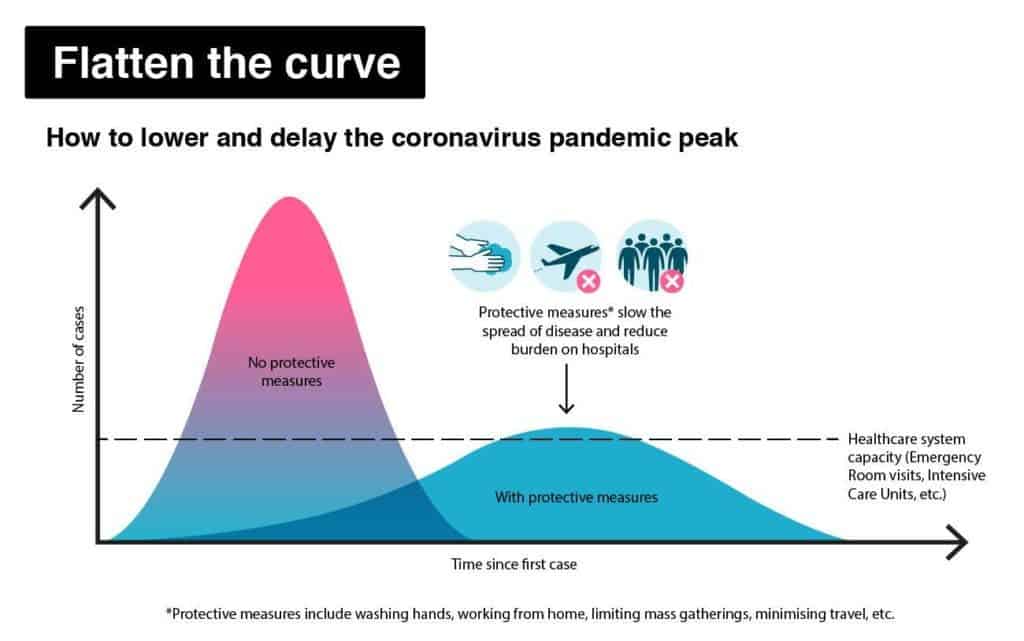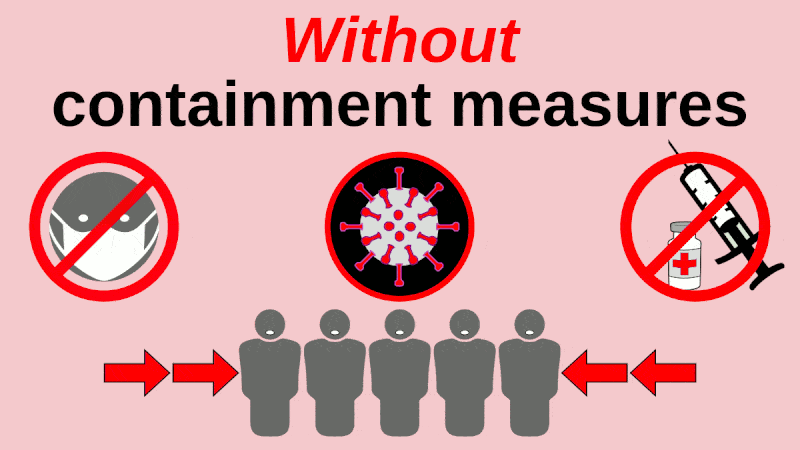Yaneer Bar-Yam uses a fire analogy. It’s a simple scenario, says the American scientist specialized in the quantitative analysis of pandemics: there’s a fire in your living room. You can go hide in the basement where you can’t smell the smoke and see the flames — or you can put the fire out.
So far there, many are headed for the basement.

US President Biden signed an order in January mandating masks in airports and on many planes, trains, ships and intercity buses. The US was one of the very few countries where this had not been mandated, and as a nation hungry for true leadership and reasonable policies, his orders were well received.
However, those familiar with pandemics might be pulling their hairs at how slowly things have developed. Bar-Yam supports temporary lockdowns as a COVID-fighting measure — especially in regards to traveling. “If there is a way to get there, the virus will be there,” he recently tweeted. It has no preferences for direct flights or whether or not the arrivals are on the east or west sides of terminals.
Our approach to the pandemic can largely be summed thusly: we’re running on skirmishes when we should be waging a full-scale war.
What are we doing now? It seems that many authorities are showing us how to co-exist with COVID-19 instead of fighting it. As a result, people are increasingly weary and disappointed by the yo-yo behavior of closings and reopenings, and having to shut down all over again while the virus remains in the winner’s circle. This is one of the major differences between countries like New Zealand or South Korea, which have quickly squashed the virus, and the vast majority of countries, which have focused on mitigation rather than eliminating the virus. Bar-Yam summarizes this difference in a recent tweet.
“Trying to keep economic activity and travel as open as possible but perpetuating the economic harm and imposing yoyo restrictions, versus making an initial sacrifice of economic activity and travel in order to benefit from the rapid restoration of normal economic activity.”
Mitigation is also important, but good luck with passively living with a such a dangerous and constantly evolving virus with no strategy to eliminate the spread community-by-community. Then, there’s also the problem of countries not reacting quickly enough to existing scientific evidence. Kimberly Prather, PhD, an aerosol scientist and member of the Covid Action Group, recently tweeted:
“Someone just asked me how sure I am #COVIDisAirborne . My response: all evidence to date points to the fact this virus travels in infectious aerosols produced in speech which can be inhaled. There is no counter evidence. It is airborne. We must say so ASAP to protect everyone.”
Vaccines can offer protection in time and they’re a way out of the pandemic. Masks help to reduce transmission. But lockdowns can also make a real difference.
Teachable outbreaks
Supporting lockdowns as a Covid-fighting strategy is Bar-Yam, a physicist and president of the New England Complex Systems Institute (NECSI). He has been studying pandemics for 15 years and thinks we have important lessons from the past to guide us through the COVID-19 pandemic.. He contributed to response protocols for stopping Ebola in Africa in 2014, for example.
In January of 2014 he spoke at the World Health Organization in Geneva about the risk of Ebola due to increasing transportation in Africa as it developed economically.
“Two months later, in March 2014, the largest outbreak of Ebola to date began in West Africa. The number of cases increased exponentially, roughly doubling every week. The response was not sufficient, and if an outbreak is growing exponentially, being behind in the response means being completely ineffective. The outbreak become the worst Ebola epidemic to date by a factor of ten.”
Scientists who do the math on pandemic transmission patterns point to risks of responding in a Swiss-cheese pattern where only some holes are being closed up (e.g., masks and social distancing) but not all holes are closed.
Bar-Yam advocates four actions to fight the pandemic more energetically: strict lockdown, travel restrictions, massive testing, masks.
We’re doing much of those, but we’ve ignored (or delayed as much as possible) the strict lockdown part, and at what price? In regards to transportation, it’s like we’re sending invitations to the virus to do its thing. Bar Yam and his coalition partners point out that their “zone” strategy is not punitive; it is designed to protect people. The strategy involves smaller local areas protected by travel restrictions.
Pandemic math
Bar-Yam has studied transmission rates. He knows that temporary shut-downs really work. They bring down the numbers, as we’ve seen in this pandemic and previous outbreaks as well. Shutting down for a number of weeks such as five weeks is what he is talking about, not shutting down for a year.
He believes it doesn’t have to take a long time. He last month tweeted how “New Zealand’s ‘go hard and early’ Covid policy reaped economic rewards. And, he more recently tweeted good news about Western Australia with over 250 days of zero community transmission. How, he asked? Low population? No. Small cities? No. “Here is how: Strong policies with ZERO as the goal, including 14 day quarantines for incoming travelers, and interregional travel restrictions. Brilliant!”
“We are all Covid-tired,” he said elsewhere in an interview, and “we don’t want to do this for a long time; we don’t want to do this for years. So the answer is, take a deep breath. Let’s do a reset. Let’s do the right thing, get together, set it up, get to zero. We can do it in 4 to 6 weeks—with distancing, with masks, with a green zone strategy.”
Message by matrix
Back in February 2020 Chen Shen and Yaneer Bar-Yam delivered a sober wake-up call in their article “Pandemic math: Stopping outbreaks,” which was posted on the NECSI site. They wrote that
“Transmission is like matrix multiplication where each person can have the disease and be contagious or not.” They proceeded to show a list of everyone with either a “0” they are not sick or a “1” they are sick. Here there are two sick people. “The contact between people is a matrix that says who has enough contact with another person to infect them.” It’s a bit like ripping a band-aid — you have the short, five week tight lockdown that’s ripping the band-air, versus a prolonger period of months of struggles.

Shen and Bar-Yam say that the matrix is not the same from day to day because people do different things. “What is most important is that we can choose to act to change the transmission network by how we behave.” The pathogen could disappear if we were to reduce the number of sick individuals to zero; then “the matrix of connections doesn’t matter. If it is not there it can’t infect anyone.”
Bar-Yam and his coalition partners point out that their “zone” strategy is not punitive; it is designed to protect people. The strategy involves smaller local areas protected by travel restrictions. It would work like this:
- Each zone is ranked regarding the degree of Covid-19 transmission.
- Green zones are a Covid-19-free jurisdiction, meaning areas where there were good signs of less virus; yellow zones are a boundary area; red zones have active transmissions.
- Non-essential travel between zones would be temporarily suspended. Isolation facilities for mild and moderate cases would prevent the infection of household members.
- Any community showing zero could start on the path to normal.
- Masks would continue to be required in all shared spaces. Frequent testing on a mass scale would speed the reopening process.
Nonetheless, one might ask, the vaccines look promising. Why go to all this bother over lockdowns when the vaccines have arrived? Unfortunately, vaccines won’t save us immediately — we still have a lot of work cut in the meantime.
As per a report from CNN, WHO’s Chief Scientist Dr. Soumya Swaminathan said that “even as vaccines start protecting the most vulnerable, we are not going to achieve any level of population immunity, or herd immunity in 2021 and even if it happens in a couple of pockets in a few countries, it’s not going to protect people across the world.”
What’s next?
Bar-Yam is part of the Covid Action Group. This is a network of pandemic experts, researchers and communicators. Their focus is how to eliminate the COVID-19 virus. Fields of expertise range from infectious diseases to applied probability science to environmental engineering.
“The world is in crisis with the exponential spread of the deadly COVID-19 virus and its variants, while the United States is in the midst of one of the most important political transitions in its history. Defeating the complex problem of COVID-19 requires a coordinated, multifaceted approach. The COVID Action Group has been created to offer support to the newly established national task force and to help guide the country forward.”
Until we are able to reach some level of vaccine-induced herd immunity, restrictions and masks are still our allies.


